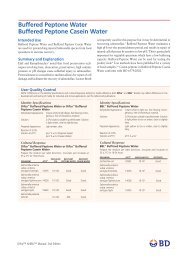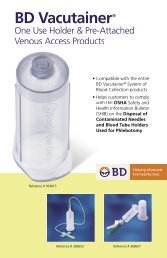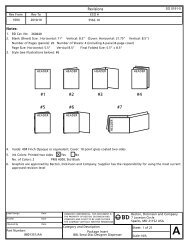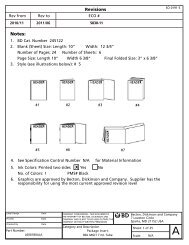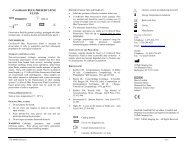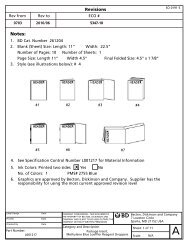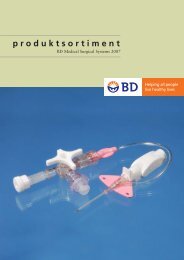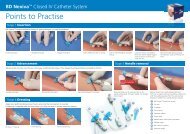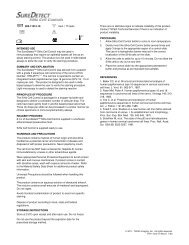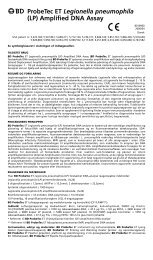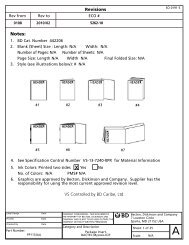Vacutainer® Urinalysis Preservative Plus Urine Tube - BD
Vacutainer® Urinalysis Preservative Plus Urine Tube - BD
Vacutainer® Urinalysis Preservative Plus Urine Tube - BD
You also want an ePaper? Increase the reach of your titles
YUMPU automatically turns print PDFs into web optimized ePapers that Google loves.
d. Hold tube in position until filled. NOTE: If the sample volume in the <strong>BD</strong> Vacutainer ® <strong>Urine</strong> Collection Cup is insufficient to fill the<br />
urine tube by closed system transfer; follow the instructions below for filling the tubes manually or by transfer straw.<br />
e. Remove tube from integrated transfer device.<br />
f. For all <strong>BD</strong> Vacutainer ® <strong>Urinalysis</strong> <strong>Preservative</strong> <strong>Plus</strong> <strong>Urine</strong> <strong>Tube</strong>s, mix tubes 8 - 10 times by inversion.<br />
g. Repeat steps c - f if another tube is to be filled.<br />
h. Replace label over integrated transfer device cavity and reseal. Use caution to avoid contact with needle when replacing label.<br />
2. Label tube(s) for transport to laboratory.<br />
3. Treat the screw cap of the cup as a contaminated sharp and discard in biohazard container approved for sharps disposal as per your<br />
facility’s recommended procedure.<br />
Instructions to transfer specimen into evacuated tube(s) using <strong>BD</strong> Vacutainer ® <strong>Urine</strong> Transfer Straw:<br />
1. If the urine specimen is collected into an alternate container, the patient gives the specimen to the healthcare professional.<br />
2. To transfer the specimen into evacuated tube(s):<br />
a. Place container on a clean, flat surface.<br />
b. Place tip of transfer straw into urine specimen. Container may be tipped at an angle if volume of urine is limited.<br />
c. Place evacuated tube into holder, stopper down. Advance the tube over puncture point to pierce stopper.<br />
<strong>BD</strong> Vacutainer ® C&S <strong>Preservative</strong> <strong>Urine</strong> <strong>Tube</strong>s should be filled first when collecting multiple tubes.<br />
d. Hold tube in position until filled.<br />
e. Remove tube from holder.<br />
f. For all <strong>BD</strong> Vacutainer ® <strong>Preservative</strong> <strong>Urine</strong> <strong>Tube</strong>s, mix tubes 8 - 10 times by inversion.<br />
g. If another tube is to be filled, leave transfer straw in container and repeat steps c - f.<br />
3. Lift transfer straw from cup and allow specimen to drain. Discard transfer straw in a biohazard container approved for sharps disposal<br />
per your facility’s recommended procedure.<br />
4. Label tube(s) for transport to laboratory.<br />
Instructions to manually fill <strong>BD</strong> Vacutainer ® <strong>Urinalysis</strong> <strong>Preservative</strong> <strong>Plus</strong> <strong>Urine</strong> <strong>Tube</strong>s:<br />
1. Hold tube upright.<br />
2. Remove stopper and place upside down on counter.<br />
3. Pour urine into tube filling between the minimum and maximum fill lines on the tube label.<br />
4. Replace the stopper securely and mix tube 8 - 10 times by inversion.<br />
5. Label tube for transport to the laboratory.<br />
Instructions For Removal of <strong>BD</strong> Hemogard Closure:<br />
1. Grasp the tube with one hand, placing the thumb under the <strong>BD</strong> Hemogard Closure (for added stability, place arm on a solid surface).<br />
With the other hand, twist the <strong>BD</strong> Hemogard Closure while simultaneously pushing up with the thumb of the other hand ONLY<br />
UNTIL THE TUBE STOPPER IS LOOSENED.<br />
2. Move thumb away before lifting closure. DO NOT use thumb to push closure off the tube. If the urine specimen contains blood, an<br />
exposure hazard exists. To help prevent injury during removal, it is important that the thumb used to push upward on the closure be<br />
removed from contact with the tube as soon as the <strong>BD</strong> Hemogard Closure is loosened.<br />
3. Lift closure off tube. In the unlikely event of the plastic shield separating from the rubber stopper, DO NOT REASSEMBLE CLOSURE.<br />
Carefully remove rubber stopper from tube.<br />
Instructions For Reinsertion of <strong>BD</strong> Hemogard Closure:<br />
1. Place closure over tube.<br />
2. Twist and push down until stopper is fully reseated. Complete reinsertion of stopper is necessary for the closure to remain securely on<br />
the tube during handling.<br />
Transport of <strong>Urine</strong> Specimen:<br />
Properly label and package tubes used to transport specimen to alternate location in accordance with your facility’s recommended<br />
procedure and applicable local, state and federal requirements.<br />
Centrifugation of <strong>Urine</strong> <strong>Tube</strong>s for Sediment Analysis<br />
Recommended Relative Centrifugal Force (RCF) for centrifugation of <strong>BD</strong> Vacutainer ® <strong>Urinalysis</strong> <strong>Plus</strong> <strong>Urine</strong> <strong>Tube</strong>s with a urine sample<br />
is 600 g for 5 minutes in a swing head centrifuge. Always use appropriate centrifuge carriers or inserts for the specific tube size. Use<br />
of tubes with cracks, chips, excessive centrifugation speed or inappropriate carriers may cause tube breakage, with release of sample,<br />
droplets, or an aerosol into the centrifuge bowl. Release of these potentially hazardous materials can be avoided by using specially<br />
designed sealed containers in which tubes are held during centrifugation. Centrifuges should be balanced and properly calibrated.<br />
Revolutions per minute (rpm) can be converted to the relative centrifugal force by the following formula:<br />
RCF = Relative Centrifugal Force<br />
r = radial distance from center of centrifuge head to bottom of tube in centimeters.<br />
EN<br />
CAUTION: Do not exceed recommended centrifugation speed. <strong>BD</strong> Vacutainer ® <strong>Urinalysis</strong> <strong>Plus</strong> <strong>Urine</strong> <strong>Tube</strong>s will withstand up to 10,000 g<br />
in a balanced centrifuge.<br />
3<br />
rpm= RCF x 10 5<br />
1.12 x r where,




